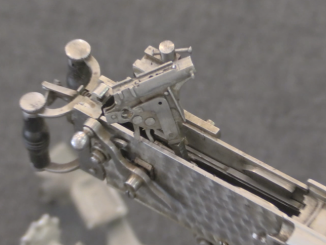During the 1930s, SIG Neuhausen made a series of really beautiful submachine guns. They were the MK series, offered in either 500mm / 19.7 inch barrels for military use or 300mm / 11.8 inch for police use. The first pattern was the MK-O, which had a rate-reducing system built into the action (which looks initially much like a delayed blowback system but isn’t). These proved too expensive, and a simplified plain high rate of fire model was introduced, the MK-S.
This example is a very rare factory semiautomatic model purchased and imported by Sam Cummings. The vast majority of the MK guns were fully automatic, but semiauto was a factory option, as police use was one of the intended markets.



Man, Swiss being Swiss… If the ”delayed bb action” actually is a ROF reducing system, why in god would you bother to add it to a semi-auto only? Just guessing, make me believe that it would be financially ”stupid” to change up the tooling and change the operating system to plain ”blowback” But hey, trying to understand some of the choices the Swiss made regarding their firearms is a whole other discussion.
“(…)change the operating system to plain ”blowback”(…)”
This did so, but was of little help http://modernfirearms.net/en/submachine-guns/switzerland-submachine-guns/sig-mkps-mkms-eng/ . Both MKMS and MKPS submachine guns were somewhat complicated and made to extremely high standards, so the price was high and sales were low. Thus, in 1935 SIG designers simplified both weapons by using simple blowback action with one-piece bolt. These guns were designated MKMO and MKPO respectively, but despite simplification, sales were still low so production was brought to an end in late thirties, with some 1,200 submachine guns of all four versions made in total.
I was aware of the mkmo and mkpo series Daweo. It just strikes me why they would bother adding the rof reducing mechanism to a semi-auto only. Just keep a short barrel variant and long barrel and keep it semi and full auto. I mean it’s obvious why they changed to the ps/ms version in just straight bb. Weight wasn’t a problem anyways since it was fully machined with a wooden stock. Also just weird that if the rof was deemed “too high” why they changed to the ps/ms version since it’s rof is close to like 1000rpm
Well, I do not know, as I do not even know why they made MKPS and MKMS at all, as they already had sub-machine in their offer at that time, namely SIG 1930 see 2nd photo from top http://modernfirearms.net/en/submachine-guns/switzerland-submachine-guns/sig-1920-1930-eng/ which already have lesser Rate-Of-Fire of 600 rounds per minute. It did not have selective fire mode, but adding one should not be huge problem (c.f. MP.28,II which is different descendant of Bergmann-Muskete). It did not have hinging magazine, but I doubt adding one would require abandoning pure blow-back operation.
Wow, not many of those ever made. I had no idea it was such a rarity. “Swiss quality … Swiss prices” is the take-away.
Most viewers are probably aware that having the very French-style magazine folding forward (also Hungarian 39.M and 43.M) not only makes for more compact carriage or portage, but also removes the ammo from the bolt raceway…an important safety feature with blowback SMGs.
The hoary-old Thomas B. Nelson tome on SMGs also thought the two-piece bolt mechanism was a blowback retarding system… But then noted that the MKMO military use fired only full-auto. So I’d wager Ian just might be spot on about it being a rate reducer. The same source thought the rpm was 900! Mighty fast. The military variant would have truly been a “maschinenkarabiner” at 1025mm/40-1/4-in. length and fully 4.7kg/11.5 pounds loaded weight!
The MKPO would shave things to 820mm/32.7-in. length and 4.37kg/10.3-lbs. weight. Contrast the lovely wood stock and lavish use of high-quality machining and metal finish on this graceful gun with the hideousness of the also-Swiss REXIM F.V. Mk.4, with its MAS-36 style spike bayonet and side-folding Sten-lookalike skeleton stock. Although the unlovely and unloved REXIM gun did fire from a closed bolt. It could also be had with enough variations of barrel length, with Thompson style compensator and cooling fins or without, with barrel. jacket or without, to satisfy the most jaded video game Call of Duty player.
These SIG Neuhausen maschinenkarabiner would really have lived up to the “carbine” moniker in the 9x25mm Mauser cartridge, no?
“(…)also-Swiss REXIM(…)”
Said company was Swiss, but https://modernfirearms.net/en/submachine-guns/switzerland-submachine-guns/rexim-favor-eng/
Some sources claim that in fact this weapon was designed in France, but its plans were stolen from French MAT factory and carried over to Switzerland. Production of this weapon was contracted to the Spanish company La Coruna, although all sales were handled by the Swiss company
Thus one might contend Swiss-ness of said weapon based at 2nd part.
I love how the locking screws on the trigger guard also have scalloped cuts that seem to allow a third locking screw for the locking screws to be added !
As Ian showed in the video, the point of the crescent cutout in the locking screw is to allow the locked screw to be turned simply by aligning the locking screw to that position. Otherwise you’d have to back the locking screw out all the way.
Definitely has M50 Reising vibes.
I think there is a Remington Model 51 hidden in this pistol caliber carbine.
(BTW, I have a similar idea: rotating bolt-based hesitation lock, from AR-15-based PCC.)
CMMG Banshee / Dissent?
“(…)rotating bolt-based hesitation lock(…)”
c.f. earlier design employing rotation for operation
Beretta M1918 http://modernfirearms.net/en/submachine-guns/italy-submachine-guns/beretta-m1918-eng/ uses delayed blowback action, in which the delay of the initial opening of the bolt is achieved by rotation of the bolt
Final form of so-called PPK-42 https://guns.fandom.com/wiki/Kalashnikov_submachine_gun used delayed blowback using a threaded shaft
ppk42,
very interesting !!!
curiously, it has 1st gen of smgs separate firing pin
The Beretta MAB18 is practically a single Villar-Perosa barrel, that infact used the same system. It’s what it’s now called “radial delayed blowback”. More than delaying the opening however, the system was used to prevent out-of-battery detonations since, for the firing pin to hit the primer, the bolt face has to be completely rotated. The system was also used in the SIA 1918 light machine gun, in 6.5 Carcano, that was also essentially a scaled-up Villar-Perosa. Probably the most powerful cartridge where the radial delayed blowback had been used.
Looking at the SIA 1918 action, it’s easy to know from where Scotti took the idea for his action. It’s practically the same, but, instead of being free to rotate, the bolt face is locked in position by the bolt body, and unlocked by a short stroke gas piston.
I see what you mean… Well, it was a good demo of the R51 perhaps… In away. In away, that is a rate reducer also… Anyway, bonnie gun; well made, nothing is made as good as that anymore.
Hesistation “lock” sticking that brass rod down hit the bolt so that is the bolt thing and slide together in the 51 I.e. The gap “Brass support potential issues etc” then… The bolt thing in the 51 does the “Locking thing in this” which rate reduces the slide so to speak. Actually my brain can’t take going through the 51 again I will leave that there.
No, actually it is simple/that; it’s just the gap… Which may/may not be an issue; those new cases with steel arse ends might solve it. Solve what? “The Gap” why it works usually? “Right fine.” Anyway…
“(…)my brain can’t take going through the 51(…)”
Then read AND comprehend whole US Patent 1,348,733. available at https://patentimages.storage.googleapis.com/ae/6c/30/ce5394db4424c0/US1348733.pdf
A rate reducer within the recoiling bolt may not be much functional…
This gun should be a member of Pedersen’s “Hesitation lock”… Since it also works in open bolt firing which adding kinetic energy to the bolt mass for slowing its recoiling velocity… That hesitation lock works as a safety against to the squip loads…
CORRECTION… “Squip load” should be “HANGFIRE”…